Overview of Common Mullein
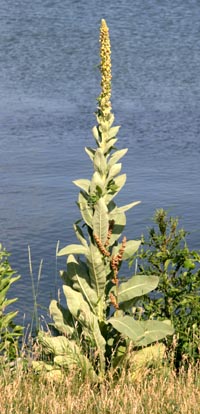
Tall flower stalks of common mullein, Verbascum thapsus, make this member of Scrophulariaceae family easily noticeable in summer along road cuts and waste areas where it thrives. Native to Europe, northern Africa and Asia, it was probably introduced to North America several times as a medicinal herb, and in the mid‑1700’s was used in Virginia as a piscicide (fish poison). Common mullein spread rapidly and had become so well established by 1818 was described as native on the East coast, reached the Midwest by 1839, and became widely naturalized on the Pacific Coast by 1876. Today common mullein is distributed throughout the U.S. and Canada wherever the growing season is at least 140 days and annual rainfall is sufficient (20 to 59 inches, or 50-150 cm), especially on dry sandy soils.
Common mullein is typically found in neglected meadows and pasture lands, along fence rows and roadsides, in vacant lots, wood edges, forest openings and industrial areas.
Although thought of primarily as a weed, common mullein has been used as an herbal remedy for coughs and diarrhea, and externally against a variety of skin problems. The flowers were also used to make yellow, green or brown dyes, depending on how they were processed.
Identification of Common Mullein
Common mullein (also known as wooly mullein) is an herbaceous biennial or short-lived perennial with a deep tap root. First-year plants appear as low-growing rosettes of felt-like leaves, with the whorl of leaves emerging from the root crown at the soil surface. Bluish gray-green, oblong to lanceolate leaves are 4-12″ long and 1-5″ wide, and are densely covered in hairs. Vernalization (exposure to cold temperatures) is required to induce flowering the following spring.


In the second year, common mullein produces a very noticeable flower stalk 5 or more feet tall. The inflorescence is a spike-like raceme, usually singular, but sometimes branched, with alternating leaves on the flower stalk decreasing in size toward the top. The stalk’s growth is indeterminate, and the length of the flowering period is related to stalk height, with taller stalks blooming longer. Small yellow (rarely white), 5-petaled flowers are grouped densely on the leafy spike and bloom a few at a time throughout the summer, maturing on the stalk from the bottom to the top in successive spirals. Each individual flower opens before dawn and closes by mid-afternoon. Flowers attract a wide variety of insects, including bees, flies, butterflies and other insects; but only short- and long-tongued bees are effective in cross‑pollination. Flowers are also autogamous, so self-pollination occurs at the end of the day on flowers not cross‑pollinated.
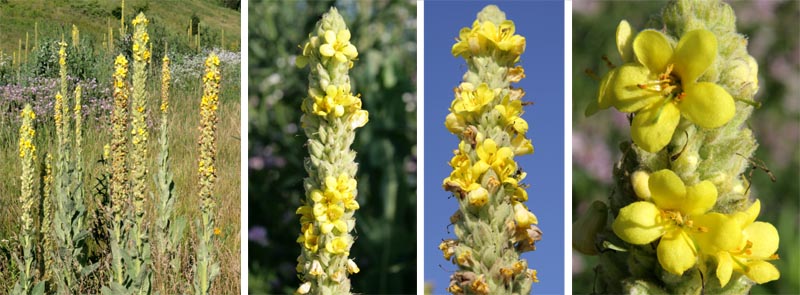
Common mullein fruit is a rounded capsule that splits into two valves at maturity, each containing dozens of tiny brown seeds. The six-sided seeds are pitted and rough with wavy ridges and deep grooves. Individual plants produce 200-300 seed capsules, each containing 500-800 seeds, so a single plant can potentially produce 100,000‑240,000 seeds. Most seeds fall within a few feet of the parent plant, falling from the capsules when the flower stalk is moved by wind or a large animal. There are no adaptations for long distance dispersal.
After flowering the entire plant dies – there is no vegetative reproduction. The dead flower stalks are rather persistent, so it easy to detect colonies of this weed at most times of year.
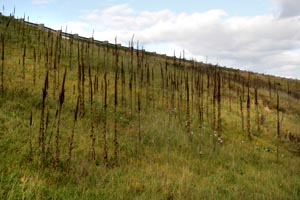
Common mullein is found in many different habitats, occurring primarily in disturbed soils in full sun. The tiny seeds remain viable for decades in the soil (seeds have been germinated after 100 years in the ongoing Beal seed longevity experiment at Michigan State University), so it is difficult to eradicate completely from an area. Seeds do not germinate well without light, so only those seeds which lie at or near the soil surface germinate, thus populations can reappear quickly after many years when seeds are brought to the surface by soil disturbance. Seedlings emerge almost entirely on bare soil, such as openings created by animal digging or road construction machinery.
Common mullein is generally not considered an aggressive weed species in Wisconsin because seed requires open ground to germinate. Since individual plants are easily destroyed by hand, it is rarely a problem in gardens and manicured yards but can be quite numerous and conspicuous in other areas at times. It is intolerant of shade, so is easily outcompeted by other plants and agricultural crops. Populations are short-lived on undisturbed sites, “disappearing” into a dormant seed bank within a few years – until the next soil disturbance.
Common Mullein Management Strategies
Common mullein is easily managed in smaller areas by manually removing the plants before flowering, preventing soil disturbance and establishing dense vegetative cover that will prevent seed germination. In larger areas, such as nature preserves, single plants and small groups on the edge of the infestation should be targeted first, then working deeper into the infestation. Pull, hoe or dig plants by hand (easiest when the soil is moist) as soon as they are big enough to hold onto, but before they go to seed.

Herbicides are generally only used when infestations are very dense but may not be effective because the hairy leaf surfaces reduces absorption of chemicals. Prescribed burning can also be used. Mowing is not effective, as the rosettes just increase in size and then bolt once mowing is stopped.
There are a number of beetles that feed specifically on this plant that could be useful for biological control, but only one has been introduced into North America. The curuculionid weevil Gymnaetron tetron was accidentally introduced into Canada before 1937 and has since spread across the continent. The larvae develop in the seed capsules, destroying all the seeds inside, but not all the seed capsules on a plant are infested. About 50% of the seeds are destroyed by larval feeding, but enough seeds remain that populations are not strongly impacted.
Common mullein is sometimes grown as an ornamental. Surface sow seed in late spring to early summer.
– Susan Mahr, University of Wisconsin – Madison
Last Update: Bruce Spangenberg, UW-Madison Extension, 2025





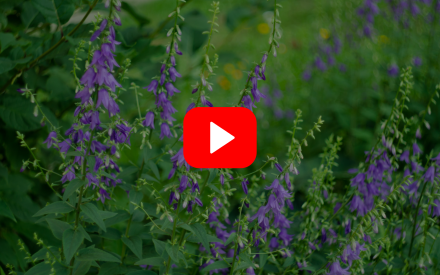 ▶ Watch: Biology and Management of Canada Thistle, Bishop's Goutweed, and Creeping Bellflower
▶ Watch: Biology and Management of Canada Thistle, Bishop's Goutweed, and Creeping Bellflower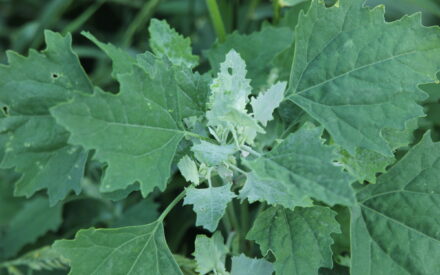 Common Weed Seedlings of the North Central States
Common Weed Seedlings of the North Central States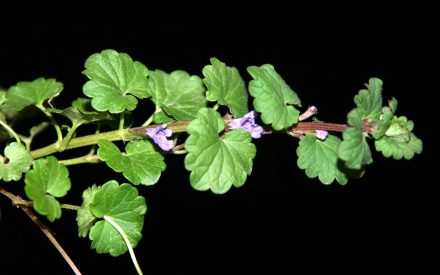 Creeping Charlie, Gleochoma hederaceae
Creeping Charlie, Gleochoma hederaceae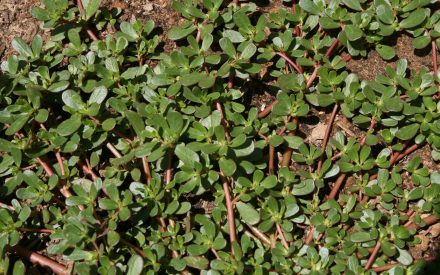 Common Purslane, Portulaca oleracea
Common Purslane, Portulaca oleracea


